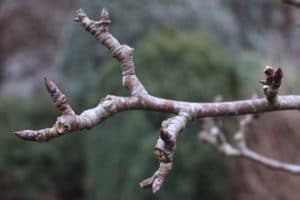Removing dead branches is one of the most important steps you can take to protect your trees, especially in the wintertime. By now we’re sure you know why the winter months are ideal for pruning trees, but going beyond a simple pruning and cutting back completely dead limbs is vital.
Willow Tree and Landscape Services arborists are frequently asked, “How can you tell which limbs are dead with no leaves?” There are numerous signs we look for to determine whether a limb is dead or alive:
- Shedding bark, cracks, fungal growth. Limbs that have been dead for a while will often shed bark, crack, or begin to have fungus grow on them.
- Shriveled leaves when all others have dropped. Oddly enough, sometimes leaves on a limb can be a sign the limb has died. If a limb dies before the tree has dropped its leaves, those leaves will often remain attached to the limb after the rest of the limbs have dropped their leaves in fall.

- No leaf buds. The buds for next year’s leaves are set by the time a tree drops its leaves in the fall. A limb without buds – or with shriveled buds – is an indicator that the limb has died. The picture above shows a tree with healthy buds.
- Snap-scratch test. If a small twig or branch breaks easily and is dry and brown on the inside, the branch is dead. A living branch will have moist, green tissue under the bark. Another way to test for this tissue is to scratch the bark off a twig.
If you have noticed any of these signs on your tree branches, give us a call. It’s important that these dead limbs be removed, before our next heavy snowstorm take care of it for you…leading to potential damage to your home, your property, or worse, an injury.
Click here to get your free tree limb removal estimate from Willow Tree and Landscape Services.

